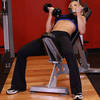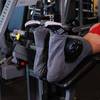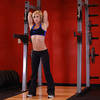Full-Time Fat-Blasting Workouts: Weight Training For Fat Loss
Although there are many benefits of cardio for fat loss, this article covers various weight training programs to lose fat. Use these 5 routines to fire up your fat loss!
Weight Workouts To Lose Fat
You live a fit lifestyle year-round but sometimes we realize the occasional junk food begins to show its effects. Being the educated fitness diva, you know it's time to start dieting and cater your workout to achieve your goal.
But for some reason when we women decide it's time to lose fat, the first thing we tend to do is jump onto cardio, and weight training is not prioritized.
Whether it's because the calorie burning advantages aren't recognized, we think weight training is to build muscle and not burn fat, we think we can't focus on lifting and losing fat at the same time, we don't know how to do an efficient weight training program, or whatever the reason. Somehow we tend to put the weights back on the rack when we want to focus on losing fat.

Women should not shy away from heavier weights.
Although there are many benefits of cardio for fat loss, this article covers the advantages of using various weight training programs to lose fat.
24/7 Metabolism Boost
First off, I'll repeat what you've probably heard many times: "Muscle burns fat". But what does that mean? Well, muscle doesn't exactly burn fat but more accurately muscle raises your Resting Metabolic Rate (RMR).
Adipose tissue (i.e. fat) takes no energy to sit on your body, that's why once it's there it will stay there until you exert enough energy to start using it as your energy source. Skeletal muscle tissue is called "active tissue" because it requires energy to maintain itself. To just sit on your body, each pound of muscle on your body uses about 30-60 calories per day.
With the right diet and workout, every female is capable of putting on 5 pounds of muscle in a year. If we estimate that your metabolism would use 50 calories per day to sustain that muscle, this means you will burn 250 more calories every day (50 calories/day x 5 pounds). With a pound of fat requiring you to burn 3,500 calories, you will lose 26 pounds in a year without spending an extra minute on cardio. ([250 calories/day x 365 days/yr]/3,500 calories/pound of fat).
Now as ladies, sometimes we brush off this advice because we don't want to get "big" or "bulky." Our society is familiar with how much 5 pounds of fat is. We see how our bodies change when we gain or lose 5 pounds of fat. What is unfamiliar to us is what 5 pounds of muscle is. Muscle is much more dense than fat.
At most gyms the trainers have a replica of 5 pounds of fat and 5 pounds of muscle. I encourage you to ask a trainer that works there or the front desk person if you could take a look at it. You'll be surprised by the volume difference and you will see there is no need to worry about adding 5 pounds of muscle.
The Afterburn
That hour of cardio was great to burn that stored energy, but when you're done on the cardio machine you're done burning calories. Weight training, on the other hand, keeps your metabolism at an elevated energy use rate for about an hour after you're done. Another bonus to weight training!
Exercise science calls this after-burn effect Excess Post-exercise Oxygen Consumption (EPOC).[1] This means that after weight training the body continues to need oxygen at a higher rate.[2] But that's a topic for an article in itself.
Weight Workout #1: Hit It Heavy
Muscle tissue growth is only stimulated when pressure is applied to it. If you use light weights and do rep after rep, your muscle will never have the stress applied to it that it needs to respond too. This means that although you eat cleaner and are on a reduced-calorie diet, your muscles will not grow.
Many dieters lighten up on their weight because they feel heavy is needed only during a bulking phase, and female dieters especially don't want to lift heavy for fear of getting bigger rather than smaller. These are myths to say the least.
Women should not shy away from heavier weights because we do not have enough testosterone to get the physique of a bodybuilder.
Lower rep/heavy weight workouts burn more calories during the workout because of greater exertion, and will ensure you will not lose an ounce of precious fat-burning muscle.
This workout uses mostly free weights because machines are designed to target individual muscle groups. This reduces the total amount of muscle involved in moving the weight. The exercises will be mostly compound to recruit more muscle fibers to work and release muscle-building and fat-burning hormones. Also, stay on your feet rather than sitting or lying down for as many exercises as possible.
Overview:
- Monday: Chest/Back
- Tuesday: Shoulders/Abs
- Wednesday: Biceps/Triceps
- Thursday: Quads/Hamstrings
- Friday: Calves/Abs
- Saturday: Cardio
- Sunday: Cardio/Abs

Decline Bench Press
Weight Workout #2: Lighten Up And Speed It Up
Doing higher reps with moderate weight could be beneficial for several reasons when it comes to fat loss. The muscle fibers used during high reps are slow-twitch muscle fibers. These hold less glycogen, therefore less glycogen will be depleted from the body during the workout. This is important for keeping the muscles full and the metabolism high.
Also, the increased lactate from high-rep training supports growth hormone (GH) output which is also a key hormone for losing fat.
Slow-twitch fibers also recover faster between sets than fast-twitch fibers. This will make it possible for adherence to using shorter rest intervals, and keep the heart rate up throughout the workout; hence burning more fat.
The same concept of using mostly free weights and compound exercises as the heavy weight workout also applies to the lower-weight, high-rep workout above. Therefore, the same exercises can be applied but the weight needs to be adjusted to allow for more sets and reps.
Overview:
- Monday: Chest/Back
- Tuesday: Shoulders/Abs
- Wednesday: Biceps/Triceps
- Thursday: Quads/Hamstrings
- Friday: Calves/Abs
- Saturday: Cardio
- Sunday: Cardio/Abs
1

Bench Dips
Weight Workout #3: Circuit Training
Circuit training is a hybrid type of interval training where anaerobic (lifting) is combined with aerobic (cardio) exercise, using higher reps and lighter weights.
In your daily circuit you will do one set on a machine, then move to do a set on another machine, and on like that 'till you complete the circuit, jump on a cardio machine for 10 minutes, and return to your first machine, with no rest in between.
Anaerobic and aerobic exercise each provide their own unique physiological benefits. A unique advantage that circuit training has is it combines both. Fast-twitch muscles are used primarily in anaerobic explosive exercises, while slow-twitch muscles are used primarily in aerobic endurance exercises.[3]
One thing to keep in mind is that you'll use at least 2 machines at a time. Remember to be courteous at the gym and only do circuit training during off hours. Gym edict does not allow you to claim more than one station while there are other people wanting to get through their workout as well.
Overview:
- Monday: Chest/Hamstrings
- Tuesday: Delts/Abs
- Wednesday: Biceps/Quads
- Thursday: Triceps/Abs
- Friday: Back/Calves
- Saturday: Cardio
- Sunday: Cardio
1
Circuit
Repeat 3 times.

Butterfly
Weight Workout #4: Double Up
Training muscles twice a week benefits not only from more-frequent training but also the split lets you focus on intensity variation. Meaning, the first workout in the week will emphasize heavier weights and fewer reps while the second workout in the week will focus on moderate weight and higher reps.
Overview:
- Monday: Shoulders/Back/Calves
- Tuesday: Quads/Hamstrings/Abs
- Wednesday: Biceps/Triceps/Chest
- Thursday: Shoulders/Back/Calves
- Friday: Quads/Hamstrings/Abs
- Saturday: Biceps/Triceps/Chest
- Sunday: Cardio
1
2
1
2
1
2
1
2

Bent-Over Rear Delt Raise
Weight Workout #5: Supersets
The superset is a super-intensity technique for fat loss and muscle building. With these you just do two exercises back to back with no rest in between.
There are several reasons why supersets are more effective than doing the regular one station at a time with rests in between each set.
First, supersets increase Lactic Acid production...[4]. Also, supersetting is time efficient. By doing sets back to back you reduce your total workout time while still doing the same amount of work.
Super setting involves doing two exercises with no rest in between.
Lastly, different super set combinations can help increase muscle-fiber activation. This means you can use specific exercise combinations to increase the intensity of work on a specific muscle, helping it develop faster.
Overview:
- Monday: Chest/Back
- Tuesday: Quads/Abs
- Wednesday: Hamstrings/Calves
- Thursday: Biceps/Abs
- Friday: Triceps
- Saturday: Delta/Abs
1
1
2
3
1

Barbell Bench Press
Conclusion
As you can see, there are many ways to use weight-training workouts as your primary fat-burning workout. Because all of these are excellent routines, it's best to do all of these in a rotation. Maybe do 4 weeks using one work out, then move to the next one for 4 weeks, and so on.
Not only will you be doing a fat-blasting workout, by switching things around you'll keep your body from acclimating and will experience the advantages of each workout. With these great weight training programs, and a fat-trimming diet, you'll see the results you're looking for!


















































































































































































Comments
Post a Comment